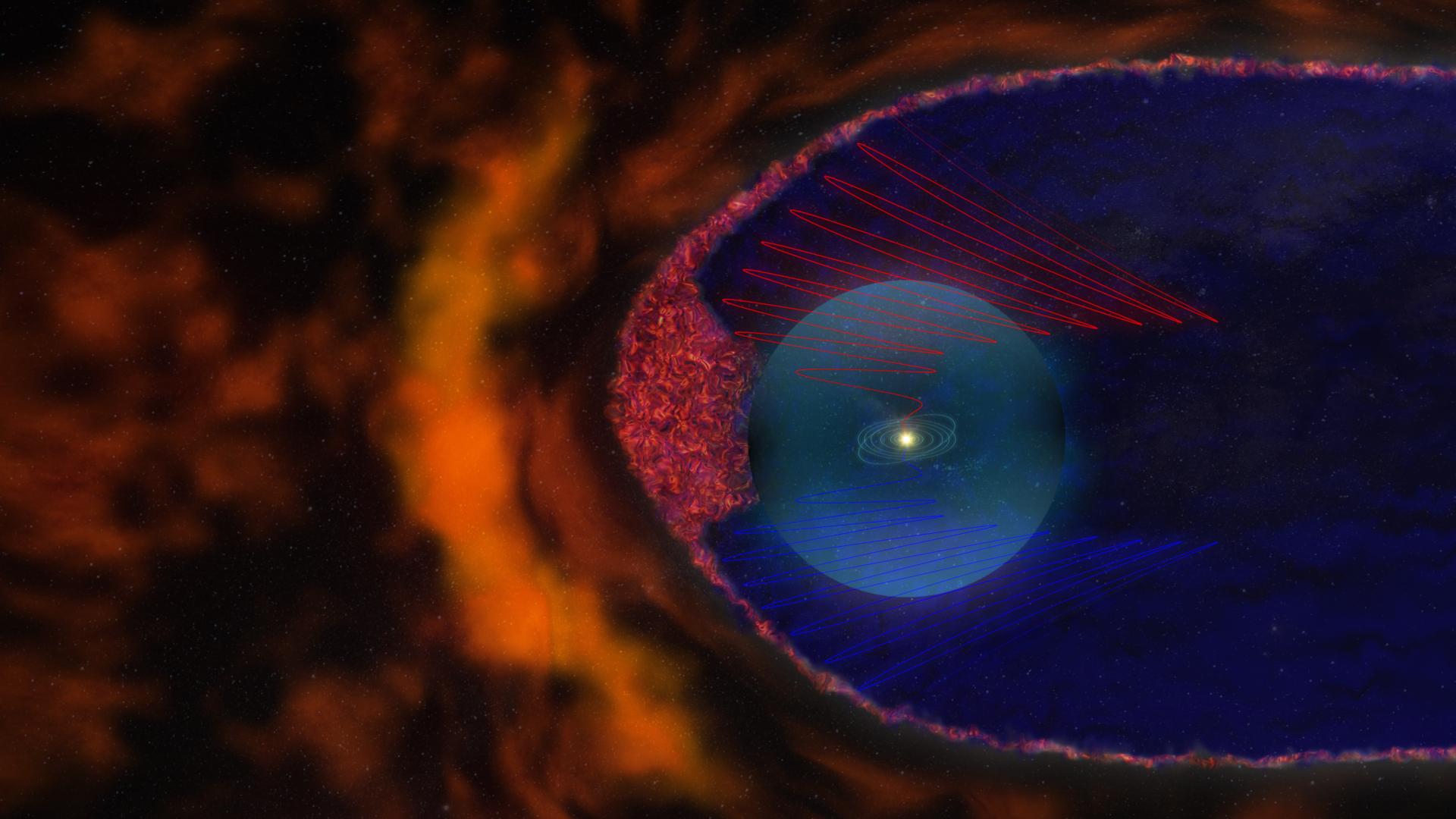

For decades, scientists have believed there to be a fairly well-defined boundary at the edges of our solar system, a region where the sun appears only slightly brighter than the rest of the spangled heavens. But as they sail through the blackness, humanity’s most-traveled spacecraft, the Voyager probes, have learned the lines are anything but clear. The edge of the solar system may not be a smooth edge at all, but a turbulent moat of roiling magnetic bubbles.
Interstellar cosmic rays flowing toward us can get trapped in the moat, churning around in the foam, and they can hitch a ride on supercharged magnetic field lines, hurtling toward the sun — and toward the Earth. Put another way, the sun’s enormous protective shield may not be a shield at all, but a permeable membrane that can be breached more easily than scientists thought.
Along with revising their theories about the sun’s protective casing, scientists may also need to revise accepted theories about cosmic rays themselves. If the moat affects how many get in, there could be more or less of them than we thought. This could change our understanding of the early Milky Way and how stars interact with the rest of the galaxy. Understanding cosmic rays will be crucial for interplanetary missions, because the low-energy radiation can harm astronauts who venture outside of Earth’s protective magnetic fields.
“The heliosphere is a window where galactic cosmic rays enter our home,” said Merav Opher, an assistant astronomy professor at Boston University who analyzed the new Voyager data. “On Earth, we are shielded by a thick atmosphere, so we don’t have to worry about that. But if you are an astronaut and you are headed to Mars, you really have to care about the charged particles in the heliosphere.”
Here’s a bit of background: The heliosphere is a bubble of charged particles encasing the entire solar system, protecting it from incoming galactic cosmic rays and the interstellar wind. The interstellar wind consists of speeding particles left over from supernovae millions of years ago, and its pressure helps dictate the size of the heliosphere. The sun’s magnetic field also has an impact.
Its magnetic field spins in opposite directions at its north and south poles, creating a twisty sheet where the two spins meet. Billions of miles away from the sun, where the Voyagers are now, the sheet starts to bunch up on itself. New data and new models show that in this twisty region, magnetic field lines criss-cross and reconnect — this is the same process that underlies solar flares, by the way — and the fields reorganize themselves, popping out into magnetic bubbles 100 million miles across.
The bubbles form a foamy froth, like “a very agitated jacuzzi,” Opher said.
The bubbles are disconnected from the broader magnetic field. Charged particles and cosmic rays must escape the bubbles to reach the magnetic field lines that do connect to the sun.
“It’s very much like they enter a highway and they quickly escape back to the sun,” Opher said.

Why does this matter? The bubbles represent a different theory of the interaction between the sun and the rest of the galaxy, Opher and others explained in a press conference Thursday.
“It changes our understanding of how (cosmic rays) get into the heliosphere from outside, from interstellar space,” said Eugene Parker, emeritus physics professor at the University of Chicago, who first proposed the twisted magnetic field theories 50 years ago. “The solar wind sweeps them back, but we have to modify our estimates of how much sweeping back is taking place.”
The bubble theory is the result of new computer models and the latest data, and physicists are still trying to figure it all out. The Voyagers are getting old — they launched 34 years ago, and their instruments were designed in the late 1960s and early 1970s — so they’re not exactly state-of-the-art. Physicists want newer spacecraft with more sensitive instruments to take more measurements so they can be sure the bubbles are real.
Bizarre as they are, they’re just the latest in a series of strange results from the Voyager probes. Last year, Voyager 1 picked up signals that suggested the solar wind was at zero. The spacecraft had already passed the termination shock, the point at which the solar wind slows down from supersonic speeds (listen to it here) but this was an odd result — what could cause the wind to suddenly peter out? Scientists suspect the wind has turned a corner, bent by pressure from the interstellar wind, said Ed Stone, Voyager project scientist based at the California Institute of Technology in Pasadena, Calif. This was unexpected, too, he said.

At a juncture called the heliopause, the sun’s magnetic influence ceases entirely, the border crossing into true interstellar space. No one is sure when Voyager 1 will reach that boundary, but Opher and Stone say it could happen within the next four years.
The bubbles have changed everyone’s expectations about what that zone will look like, Opher said.
“The heliopause is not a shield, but more like a porous membrane, with fingers and indentations,” she said. “We are speculating that the heliopause would be patchy and turbulent.”
Voyager 1 and 2 are powered by radioisotope thermoelectric generators, and have enough juice to last at least another 5 years, said Arik Posner, Voyager program scientist with NASA’s heliophysics division.
After exploring the solar system in unprecedented detail in the first half of their lives, it appears their work is only just beginning.

